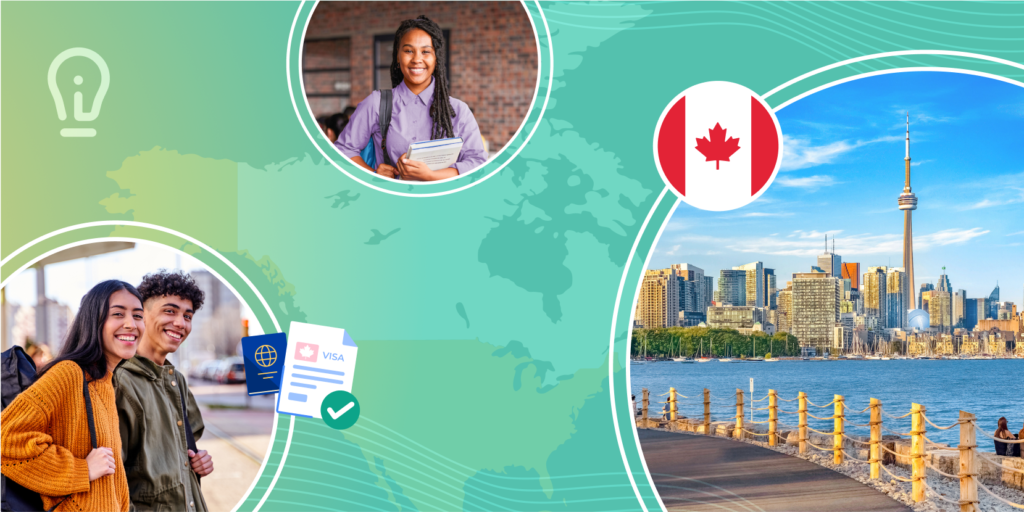The Canadian international education landscape has evolved considerably over the past six months. Now that Immigration, Refugees and Citizenship Canada (IRCC) has shared data from Q1 2024, we’re starting to see how the temporary study permit cap is influencing international students’ decisions to study in Canada.
Note that study permit processing was temporarily paused for select programs1 while provinces received study permit allocations for 2024 and implemented their provincial attestation letter (PAL) processes. Permit processing for these programs stopped nationwide on January 22, 2024, and provinces had to establish and launch their PAL process by March 31, 2024, before processing could restart.
Now that study permit2 processing has resumed, the data is starting to illustrate the effects of these updated policies. Let’s look at how interest from different student markets has shifted, how a delay in study permit processing may impact incoming students, and more.
Key Insights at a Glance
- March was the first month in 2024 where the total number of new study permits processed decreased year-over-year, and the drop was considerable: while 70,000 permits were processed in March 2023, only 33,000 were processed in March 2024.3
- Study permit processing times rose through 2024, taking nearly twice as long in May as in January. This delay means the true shift in student demand won’t be clear until later in the year, as the backlog clears.
- Indian students accounted for about one-third of all post-secondary study permits processed in Q1 2024, and over 55% of all approvals. However, March saw a historically low number of permits processed for Indian students (just over 4,000), which could be the first indication of seismic shifts in incoming student demographics.
- Some inbound post-secondary student populations saw higher approval volumes year-over-year in Q1, including those from Bangladesh, Ghana, Guinea, and Senegal. Ghanaian students received the second-highest number of approved permits in Q1, surpassing Nigerian and Chinese student populations.
Rising Canadian Study Permit Processing Times Slow Applications
The average Canadian study permit processing time has increased steadily in 2024, from 8 weeks in January to about 15 weeks in May:4
Late winter and early spring are often busier times for application processing as students apply for programs that begin that autumn. Usually, the rush tapers off in April and May and processing times decrease before lengthening again in the summer.
In 2024, however, the partial halt in application reviews while provinces created PAL distribution processes contributed to shifting processing volumes to later in the year. When PAL processes launched throughout March, it’s likely that processing times crept upward as students who held off on submitting their study permit applications sent them in. Processing times also grew in April as some provinces, like Ontario, didn’t reopen applications until the end of March.
Per the most recent available data, processing times may be starting to come down: average turnarounds in mid-June were 12 weeks, versus 14 or 15 weeks in May. Even so, we expect that turnaround times will remain higher than usual into the summer as IRCC clears the backlog.
To bolster student confidence, institutions can share clear communication with incoming international students on this topic. Students should understand study permit processing times are longer than usual—and that delays don’t reflect on their application’s quality, or mean it’s lost in the process.
Canadian Post-Secondary Study Permit Approval Rates Dip
Between January and April 2024, IRCC processed over 152,000 post-secondary study permits. Of those, over 76,000 were approved. This is an overall approval rate of 50%, eight percentage points lower than the 2023 average and five percentage points lower than 2022’s average of 55%:
The difference between the number of permits processed so far in 2024 and the other years looks stark. However, remember that processing for all undergraduate and some postgraduate programs was fully paused for at least one month, and in many cases, longer. Plus, longer study permit processing times mean that fewer applications were processed than at this point in previous years.
If application numbers and approval rates remain steady throughout 2024, the projected number of approved post-secondary study permits is around 229,000,5 which is not far from 2019’s total of 217,000 permits approved. However, the federal government’s new study permit cap is based on a 60% approval rate for 2024, not the current rate of 50%. As recruiters, governments, and students adapt to the updated processes, we predict student interest levels and approval rates will recover through the summer and fall so that 2024’s final study permit approval numbers will align more closely with the government’s cap of 292,000.
Students from Four African Countries Bolster Canadian Study Permit Applications in Spring 2024
In Q1 2024, Ghana became Canada’s second-largest source country for international students based on post-secondary study permit approvals. It surpassed both Nigeria and China, which fell to third and fourth place respectively:
According to the latest IRCC data, two thirds of all international student populations6 had a lower study permit approval rate in early 2024 versus full-year 2023. Although Ghanaian and Nigerian students are Canada’s second and third largest sources of students so far this year, their approval rates dipped in 2024. Ghanaian students saw an approval rate of 32% in 2024, down from 44% in 2023. Over the same period, the approval rate for Nigerian applicants dropped from 32% to 16%.
The 2024 mid-year rates for these countries are still better than they were in 2020 and 2021, but it’s a concerning downturn. Lower approval rates could be due to a number of factors, whether it’s due to students submitting applications without the necessary supporting documents or applications that come in with the outdated proof of finances amount. Canada’s increased proof of finances requirement came into effect on January 1, 2024, to reflect the country’s increased cost of living, but may have been missed by some applicants close to its rollout date.
Despite lower approval rates, interest levels from many African students remains high. Student demand from 12 of the 17 African source countries7 rose in Q1 2024 compared to Q1 2023, based on submitted study permit volumes. This included students from Ghana and Nigeria, along with applicants from Algeria, Guinea, and Cameroon.
Learn more about how African students could be central to ensuring campus diversity in Canada.
Indian Students’ Canadian Study Permit Applications Decline Sharply in March 2024
Almost 45,000 study permit applications for Indian students were processed by IRCC in January and February 2024. However, in March 2024, IRCC only processed 4,210 study permit applications for Indian students:
While it’s too early to make definitive statements—and our team is watching the data to gauge how student markets are evolving—various factors may contribute to waning student applications from India. For one, student loans in India are becoming harder to secure.8 Furthermore, Indian-Canadian relations are strained, and several high-profile media stories may be giving prospective students pause.
Beyond these factors, the downturn in Indian student applications is likely rooted in what Indian students want to study in Canada. In 2023, over 90% of study permits processed for Indian applicants were for now-capped study programs, such as college diplomas and university undergraduate degrees. This was the third-highest rate among the top 10 source countries. Only student populations from Nepal and the Philippines showed a greater focus on program types that are affected by Canada’s temporary cap. As a result, news around the cap and application freezing in January likely had a disproportionate impact on Indian study permit applications, compared to others.
That said, Canadian student visa applications which have been submitted by Indian students are more likely to be approved than ever: their 2024 Q1 study permit approval rate shot past its then-record rate of 73% in 2023 to rise to 85%.
How are other destinations evolving in 2024? We look at new UK Home Office data to see how the United Kingdom’s international education sector is navigating change.
Key Takeaways
While this early 2024 data shows how policy updates are affecting study permit application volumes and processing times, we’ll gain a clearer picture over the next couple of months. As study permit processing continues for the fall intake, how many approvals are given and how they’re divided will shape institutions across Canada.
Given the limitations placed on institutions by temporary study permit caps, it may be tempting for institutions to prioritize students from countries with historically higher visa approval rates. However, given the potential slowdown of Indian students’ interest in Canada, and how approval rates are shifting in 2024, the most balanced approach may be through encouraging acceptance of students from a diverse range of countries when reviewing applications. Institutions that build diversity into their recruitment process will generally be less affected by reduced interest or access from an individual country. They also build a learning environment where a wide range of perspectives and lived experiences can strengthen everything from class discussions to research approaches.
Canada’s temporary study permit application cap will continue to change how international students approach their studies. Despite this ongoing evolution, there are real opportunities here for academic institutions to update their processes and become more responsive to student needs. As a sector leader in document verification and agent training, ApplyBoard is proud to work with institutions across Canada on streamlining international student recruitment. We help to reduce administrative time, confirm the veracity of key application documents, and more. Now that every PAL counts, our work to ensure higher conversion rates can make a meaningful difference both to your institution and hopeful international students.
For data-backed guidance on how you can maximize conversion rates, please contact your Partner Relations Manager. Or, reach out to ApplyBoard’s Partner Relations team at schoolpartnerships@applyboard.com to start a conversation.
Subscribe to ApplyInsights
Sign up for the latest insights on international education.

About the ApplyInsights Team
FOOTNOTES:
1. PALs are now required for all international students pursuing undergraduate studies, graduate diploma, or graduate certificate programs. K-12, master’s degree, and doctoral degree programs are exempt from this requirement. Study permit extensions are also exempt. As such, the statistics used in this article reflect new study permits, and exclude extensions.
2. The terms student visa and study permit are generally used interchangeably for Canadian international students. Rather than student visas, Canada provides accepted international students with study permits. These allow those students to enrol in classes at Canadian institutions. When a student is accepted for a study permit, they are also usually provided with a visitor visa, which allows that student to enter Canada for their studies.
3. All data is courtesy of Immigration, Refugees and Citizenship Canada, unless otherwise stated.
4. Processing times for students from each source country are calculated by the IRCC on an eight-week rolling basis. Each week, the presented processing time accounts for the average number of calendar days from student submission to IRCC decision rendered on 80% of all applications that received a decision from the IRCC in the previous eight-week period. Weekly averages are then averaged over each month to obtain monthly averages.
5. If the study permit approval rate remains constant at 50%, and study permit application volumes don’t change from their January–April levels, a similar number of study permits will be approved in each of the next two thirds of 2024. When the number of approvals to date (76,307) are multiplied by 3, we get 228,921.
6. Students from 58 of the 176 countries who have had a Canadian study permit processed so far in 2024 have a better approval rate in the first third of 2024 versus the full year of 2023.
7. African countries whose students submitted over 500 Canadian study permit applications in Q1 2024 were included in this calculation.
8. Nair, Abhishek. “India’s education sector braces for change as Modi wins third term,” The PIE. June 2024.






